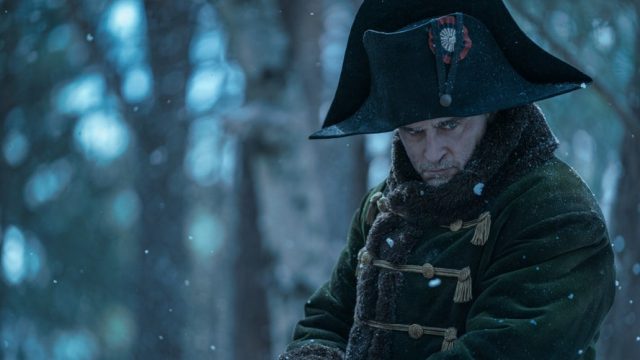This Week You Will Hear Legends from the Battlefields of:
- France
- Oklahoma
- Hollywood
- the editing room
- the hearts and minds of the public!
Thanks to the legendary nikmarov for contributing this week! Send articles throughout the next week to ploughmanplods [at] gmail, post articles from the past week below for discussion, and Have a Happy Friday!
The New Yorker‘s Michael Schulman profiles Ridley Scott and draws comparisons between him and the subject of his new epic Napoleon:
Scott regards his œuvre with pugnacious pride, especially his less loved films, such as the 2013 crime thriller “The Counselor,” which he maintains was the victim of bad marketing. (“They fucked it up.”) When a movie fails, I asked, does he question his instincts? “No,” he grunted. “I blast the shit out of a tennis ball.” Beside him was Pauline Kael’s four-page evisceration of “Blade Runner,” which ran in this magazine in 1982 and contains, among other gibes, the line “Scott seems to be trapped in his own alleyways, without a map.” Scott had the review framed for his office wall years ago and had asked an assistant to lay it on the table for me; I got the sense that he had agreed to a New Yorker Profile in order to have the last laugh.
For MUBI, Matthew Thrift gets Thelma Schoomaker to break down key scenes of films by her late husband Michael Powell (with some great screengrabs and insight):
SCHOONMAKER: I think what Marty admires so much about [Peeping Tom] is that it absolutely lays down the dangers of filmmaking. And we are destructive sometimes. Don’t ever rent your house to a filmmaker. Our personal lives are deeply affected by the demands of the job. I work insane hours, and when Michael was alive it was very painful for me not to be able to go home and make him dinner sometimes. It’s destructive, but it’s also such a wonderful, creative outlet that you become addicted to it. It can affect your life dangerously, and that’s what he’s showing here so brilliantly. Just brilliantly.
Speaking of Scorsese collaborators, cinematographer Rodrigo Prieto talks Killers of the Flower Moon with Filmmaker Magazine‘s Daniel Eagan:
I learned about how the position of the sun was an important element in [Osage] rituals. That’s why when Mollie [Lily Gladstone] is praying at sunrise, we see the sun in the frame. At the bearing of the pipe ritual in the beginning of the movie, we have this hot spot lighting the person who’s leading the ceremony. Later, in the lodge where the 25 original families are meeting, I created a circle of sunlight in the middle of the room. Even Lizzie’s [Tantoo Cardinal] burial takes place at noon, a very specific choice for the Osage. Burials occur when the sun is in its zenith.
The Ringer‘s Vince Mancini examines what he calls the peculiar rise of the vanity biopic:
These kinds of biopics seem to be classic examples of saying one thing and doing another. They sell a fraudulent idea of success while downplaying all the canny self-promotion, shrewd politicking, and cutthroat competitiveness that actually brought their subjects to a place of fame or success. They’re “inspirational” at the expense of being interesting, and worst of all, they don’t offer the kind of insights into the human condition they might have had they been produced at more of a remove from their subjects. At a more basic level, it seems like Hollywood assumes that audiences want to see more movies about nice people behaving responsibly. At the risk of stating the obvious, movies about historical dead guys—Oppenheimer and Napoleon, say—aren’t bound by the same rules. They’re allowed to just exist without being referendums on the goodness of their subjects. We’ve known, at least since Citizen Kane, that subjects who lie, cheat, steal, and act ruthlessly, cravenly, and vainly are often more interesting, and more edifying.
And at LitHub, Foster Hirsch details the how 1950s Hollywood failed in their question to give literary classics the big screen treatment:
Although American filmmakers might be presumed to be more at ease with native classics than with Russian, home-grown masterworks like Moby Dick and The Old Man and the Sea proved equally untameable movie material. Man faces the sea in starkly allegorical battles in the Melville and Hemingway stories, and try as they do, the films cannot lift the ocean and its creatures to the metaphorical heights they attain in the novels. On film, the sea is the sea is the sea, a whale is a whale is a whale.


